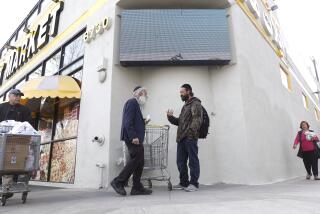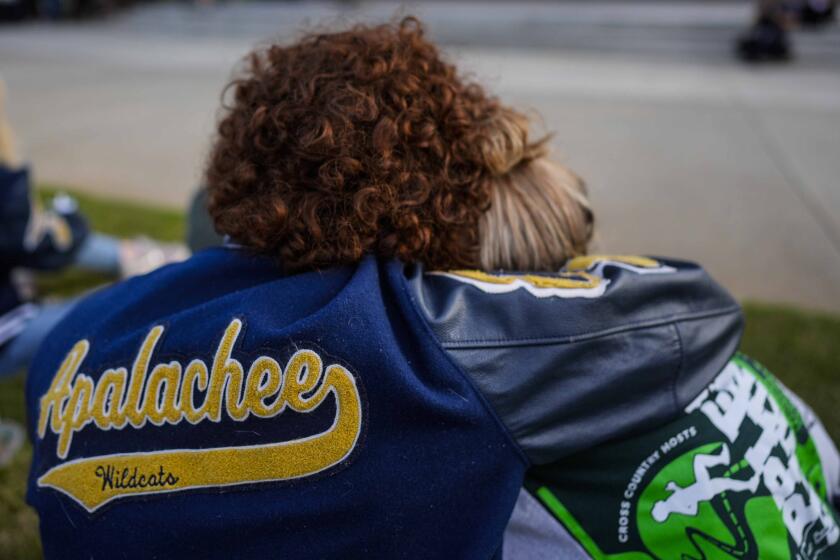An exodus to Vegas
Las Vegas — Las Vegas
More than 3,000 years after the Exodus, the Jews have returned to the desert, this time settling into sprawling new subdivisions with greenbelts and swimming pools and taking jobs in gleaming office buildings.
This is not some Zionist dream to convert the Judean desert into the new land of milk and honey. This is the 21st century version of Sodom and Gomorrah.
This is Lost Wages, Sin City, the U.S. capital of the gambling and sex trades. It is also home to the fastest-growing Jewish population in the United States.
The statistics are staggering. Hundreds of Jews pour into Las Vegas each month, primarily to feed a shortage of doctors, teachers, accountants and other professionals created by the transformation of the once-small tourist town into the nation’s fastest-growing metropolis.
The Jewish community grew by nearly 20,000 residents, or 35%, to 75,000 from 1995 to 2000, according to the American Jewish Year Book, and is estimated to have crossed 80,000 this year, giving Las Vegas a Jewish population bigger than those of either Orange or San Diego counties.
Where once Jews made up just a tiny fraction of the population in Nevada’s Clark County, they are now approaching 5%, about double the national average.
Las Vegas has kosher restaurants, two Jewish newspapers and two Jewish grade schools. It has a Jewish mayor, a Jewish congresswoman and a cadre of Internet-ordained rabbis who cater to the town’s 24-hour wedding trade. Several real estate agents specialize in finding homes for observant Jews within walking distance of any one of the community’s 20 synagogues.
When pediatric gastroenterologist Howard Baron moved to Las Vegas a decade ago, his wife, Bonni, joined a co-op of several observant families to order kosher meat shipments from Los Angeles and Phoenix. Today Bonni can get just about any food product locally -- one Albertson’s has even added a kosher meat counter and deli.
Baron, 42, came to Las Vegas because it was a city of opportunity, a place desperately in need of medical specialists like him. After finishing a fellowship at UCLA 10 years ago, he could have returned to his home state of Minnesota to join a medical partnership making $80,000 a year. Instead he accepted a $120,000 offer from a practice in Las Vegas, a salary made even more attractive because Nevada has no state income tax.
Baron, his wife and their young daughter, Alayna, settled in the Green Valley neighborhood of Las Vegas. Technically a part of Henderson, Nev., this community within an easy drive of the Strip is characterized by manicured lawns, bike paths and greenbelts, which, if not for the surrounding desert, could be mistaken for Irvine. A few years later, the Barons’ second child, Zoe, was born.
Initially Baron wondered if his family could settle into the type of Jewish life he and Bonni had grown up with in Minneapolis. The family attends religious services at least once a week and keeps Friday nights clear, reserving the evening to light the traditional Sabbath candles and say the ritual blessings over wine and the braided challah bread.
“To be observant here presents challenges compared to other cities where generation after generation of Jewish families have lived,” said Baron, who helped found his neighborhood synagogue, Midbar Kodesh (Holy Desert) Temple. “You have to be a pioneer. Your children can’t just show up at youth activities, you have to create the youth group.”
Baron is a pioneer in other ways too, serving as a modern-day Moses leading a new group of Jews into the desert. “My in-laws moved here about five years ago,” Baron said. “My mother just arrived here, a year and a half after retiring from a job she held in our Minneapolis suburb for 27 years.
“One of my wife’s second cousins moved here a few years ago from Minneapolis,” Baron added, noting that the cousin’s parents also just bought a home across town.
Almost from the beginning, Jews have played a role in Las Vegas’ development. A century ago when the town was a railroad depot, a handful of merchants were the first to arrive, attracted by the commercial opportunities typical of the towns that dotted the Old West.
Yet it was a second migration -- the arrival of a Jewish band of mobsters with Mafia ties in the 1940s -- that turned Las Vegas into something more than a way station in the middle of the desert. The manic murderer and Hollywood wannabe Benjamin “Bugsy” Siegel and mob associates such as Meyer Lansky, David Berman and Gus Greenbaum built hotels and casinos and persuaded their cronies to run them. These were members of the “tribe” -- Jewish dealers, bellmen, cabdrivers, cooks and other blue-collar workers who could be trusted to keep quiet about shady business dealings.
It’s no coincidence that Sin City’s first synagogue opened in 1946, the same year Siegel opened the landmark Flamingo hotel. Temple Beth Shalom gave this “kosher nostra” a place where their sons could become bar mitzvah and their daughters could be married under the traditional chupeh, or canopy. No one really cared that gambling and mob activity paid for the building and just about every event within it.
But the Jewish mafia faded as the gambling industry was taken over by outsiders, first by eccentric millionaires such as Howard Hughes and then by the big public hotel companies. The original influx of Jews died off, and for years Las Vegas was viewed as a pariah city by parts of the Jewish community. It was a place to visit but not to live.
Siberia yes, Las Vegas no, was the long-standing policy of Rabbi Menachem Mendel Schneerson, the charismatic “Rebbe” of the ultra-orthodox Chabad movement. Schneerson barred his rabbis from venturing to the city despite their global mission to bring unobservant Jews back into the fold.
But even Schneerson could not resist the opportunities waiting in Vegas. Though he rarely left the red brick Chabad headquarters in Brooklyn prior to his death in 1994, Schneerson understood the demographic changes taking place in the Nevada desert. In December 1990 he directed one of his students, Rabbi Shea Harlig, to move to Las Vegas as Chabad’s shliach, or emissary. His orders: Get assimilated Jews to reconnect with their religion and find wealthy donors to fund the project. Harlig did both. Within a decade, three Chabad centers and an elementary school were built.
The new Jews of Las Vegas make up a portion of what Hal Rothman, a historian at the Gaming Studies Research Center at the University of Nevada, Las Vegas, calls a “professional class” required to make the new corporate Las Vegas function. But a few vestiges of Jewish gangland’s contribution remain.
A memorial plaque for Siegel on the grounds of the Flamingo hotel notes the gangster’s role in the development of the city, though none of the property’s original structure remains.
Moe Dalitz’s name adorns the school building at Congregation Ner Tamid, an honor to one of the Jewish congregation’s major donors and a guiding light in the development of the casino town. His name also shows up in nearly 3,000 pages of FBI files compiled during decades of investigations into racketeering, bank fraud and other criminal activities dating back to the Prohibition Era.
Rabbi Sanford Akselrad of Ner Tamid is one of the last links to that era, having officiated at the funeral of Dalitz in 1989, shortly after becoming the spiritual leader of the Reform congregation. For most of the Jews who now live in the desert, said Akselrad, the mob reign is nothing more than a curiosity.
But what the mob spawned is hard to ignore. From the “sophisticated” topless musical revues at the top-end hotels to the tawdry strip joints and provocative billboards for escort services that pepper the landscape, the gambling and sex trades on which Vegas was built give a good deal of discomfort to the devout Jews who are trying to coexist.
“There still is a stigma to Las Vegas and all that it is built around,” said Harlig, who avoids driving certain streets with his seven children because of sexually suggestive advertising.
Rabbi Jeremy Wiederhorn of Midbar Kodesh Temple said that even after three years in Las Vegas he still finds it strange “walking through a smoke-filled casino at one of the hotels to get to a bar mitzvah or wedding reception.” Yet the rabbi sees spiritual opportunity in reaching the thousands of mostly unobservant Jews who have moved here.
A survey by Chabad of the local synagogues found that just 10% of the community attended Yom Kippur services last year. Harlig estimates that at best just 4,000 to 5,000 residents are active participants in Las Vegas Jewish organizations and that most of the population is assimilated and nonreligious.
“People who are willing to pack themselves up and move to Las Vegas are rarely searching for spirituality,” said Harlig, whose religious zeal is not unlike that of a Christian missionary.
Although the more religious of the newcomers will find the synagogues, restaurants and markets that make Jewish life palatable, Las Vegas is still missing many of the institutions people expect in more mature communities, said Meyer Bodoff, executive director of the Jewish Federation of Las Vegas.
There is no Jewish community center, no Jewish home for the aged or assisted living services, no Jewish high school, he said. “In truth, we are not the fastest-growing Jewish community in North America, we are the fastest-growing population. Now we have to build a community,” said Bodoff.
As much as a quarter of the population is retirees, people like former accountant Saul Yarmuk, who was attracted by the low cost of living in Las Vegas and relieved to say goodbye to the smog and traffic of the west San Fernando Valley.
“If you had told me 10 years ago that I was going to live in Las Vegas, I would have said you were meshuganah,” said Yarmuk, 69, following a weekday afternoon service at Harlig’s congregation.
But the local rabbis and other lay leaders concede that the heavy percentage of retirees also hinders development of a cohesive community. The seniors typically settle into the sprawling Sun City retirement communities, where they look for a rabbi to lead some social events and holiday services and to be available for life cycle events -- funerals. Many have poured money and time into Jewish organizations in their former communities and no longer have the inclination to play the role of builders, said Rabbi Akselrad.
Community building also is hampered by a growing geographical divide. The Vegas population is split evenly between the Green Valley area and Summerlin, where an expanse of highway cuts a white ribbon through the tan and khaki desert until it arrives at endless stucco and pink-tile-roof subdivisions -- places like Toscana, Vistano and Southern Terrace.
Each region would like a planned Jewish community center, but initially there will only be enough money for one. Bodoff hopes that as Jews here become a more cohesive community, enough funds will be raised to eventually have two centers.
He attributes this all to the growing pains of a rapidly expanding population in a city that is transitioning into a major metropolis.
“There are many things we need to grow into, and it is going to take some time, but if you look at the Jewish community here today and then come back in six or eight years, it will be entirely different,” Bodoff said.
More to Read
Sign up for Essential California
The most important California stories and recommendations in your inbox every morning.
You may occasionally receive promotional content from the Los Angeles Times.











